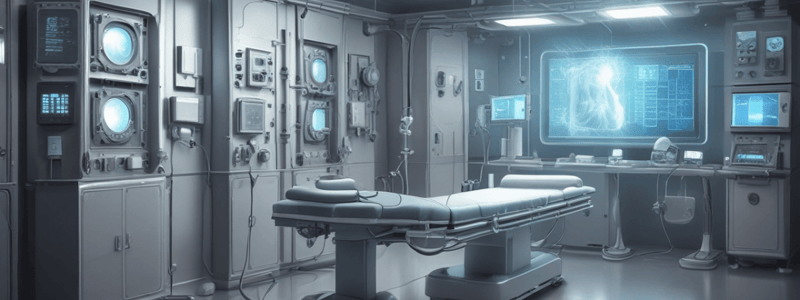Podcast
Questions and Answers
What percentage of kVp decrease is recommended for children compared to an adult?
What percentage of kVp decrease is recommended for children compared to an adult?
- 20%
- 15%
- 25% (correct)
- 10%
What is the purpose of filtration in fluoroscopic equipment?
What is the purpose of filtration in fluoroscopic equipment?
- To reduce radiation exposure to the patient (correct)
- To increase the kVp range
- To increase the image intensity
- To improve image resolution
What is the minimum acceptable HVL of aluminum when the kVp range is between 80 and 100?
What is the minimum acceptable HVL of aluminum when the kVp range is between 80 and 100?
- 2 mm
- 5 mm
- 4 mm
- 3 mm (correct)
What is the minimum SSD requirement for stationary fluoroscopes?
What is the minimum SSD requirement for stationary fluoroscopes?
What is the function of the cumulative timing device?
What is the function of the cumulative timing device?
What is the maximum entrance skin exposure rate for general-purpose intensified fluoroscopic units?
What is the maximum entrance skin exposure rate for general-purpose intensified fluoroscopic units?
What is the maximum entrance skin exposure rate for fluoroscopic units equipped with high-level control (HLC)?
What is the maximum entrance skin exposure rate for fluoroscopic units equipped with high-level control (HLC)?
Why is it important to minimize the height of the image intensifier entrance surface above the patient?
Why is it important to minimize the height of the image intensifier entrance surface above the patient?
What is the purpose of Setting the Technical Exposure Factors for children?
What is the purpose of Setting the Technical Exposure Factors for children?
What is the requirement for SSD in mobile fluoroscopes?
What is the requirement for SSD in mobile fluoroscopes?
Flashcards are hidden until you start studying
Study Notes
X-Ray Beam Limitation Devices
- The primary x-ray beam should be collimated to the size of the image receptor (IR) being used for the examination.
- This is achieved using a light-localizing variable-aperture rectangular collimator, which adjusts the size and shape of the x-ray beam.
- The collimator is the most popular x-ray beam limitation device.
Types of X-Ray Beam Limitation Devices
- Light-localizing variable-aperture rectangular collimator
- Aperture diaphragms
- Cones
- Cylinders
Function of X-Ray Beam Limitation Devices
- These devices confine the primary beam before it enters the area of clinical interest, limiting the quantity of body tissue irradiated.
- They reduce scattered radiation in the tissue and prevent unnecessary exposure to tissues not under examination.
Exposure Reproducibility and Linearity
- Exposure reproducibility refers to the consistency in output radiation intensity for identical generator settings.
- Variance of 5% or less is acceptable.
- Exposure linearity is the ratio of the difference in mR/mAs values between two successive generator settings to the sum of those mR/mAs values.
- It must be less than 0.1.
Radiographic Grids
- A radiographic grid is a device made of parallel radiopaque strips alternately separated with low-attenuation strips.
- The grid's purpose is to reduce scattered radiation and improve image quality.
Radiation Safety Features of Digital Imaging Equipment
- The radiographer's responsibility is to minimize radiation exposure by using correct technical exposure factors.
- The radiographer can manipulate the image to avoid overexposure.
- CR phosphor sensitivity is approximately equal to a 200-speed screen-film combination.
- CR has greater kilovoltage flexibility than conventional screen-film radiography.
- X-ray beam collimation and centering of the body part on the CR cassette are essential.
- Radiographic grids should be used frequently, except for the majority of pediatric patients.
Radiation Safety Features of Fluoroscopic Equipment
- Fluoroscopic procedures require intermittent, or pulsed, fluoroscopy to reduce patient dose.
- The last-image-hold feature is beneficial.
- Limiting fluoroscopic field size reduces patient dose.
- Technical exposure factors for adult patients include:
- kVp range: 75 to 110 kVp, depending on the body area being examined
- SSD not less than 38 cm (15 inches) for stationary fluoroscopes; not less than 30 cm (12 inches) for mobile fluoroscopes
- Selection of technical exposure factors for children involves:
- Decreasing kVp by up to 25%
- Decreasing technical exposure factors, maintaining SSD, and minimizing the height of the image intensifier entrance surface above the patient
- Filtration is required, with a half-value layer (HVL) of 3 to 4.5 mm aluminum.
- SSD should be no less than 38 cm (15 inches) for stationary fluoroscopes; no less than 30 cm (12 inches) for mobile fluoroscopes.
- Cumulative timing devices are required to monitor fluoroscopic exposure time.
- Exposure rate limitation is essential, with a maximum of 100 mGy per minute (10 R/min) for general-purpose intensified fluoroscopic units, and 200 mGy per minute (20 R/min) for units equipped with high-level control (HLC).
Studying That Suits You
Use AI to generate personalized quizzes and flashcards to suit your learning preferences.




